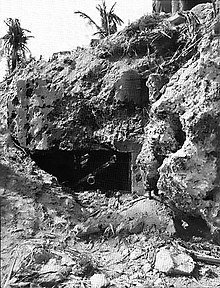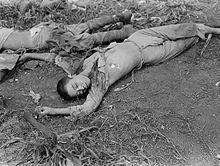Battle of Guam (1944)
| date | July 21, 1944 to August 10, 1944 |
|---|---|
| location | Guam ( Mariana Islands ) |
| exit | American victory |
| conflict parties | |
|---|---|
| commander | |
|
Gen. Roy S Geiger |
General Takeshi Takashima , |
| troop strength | |
| 36,000 American Marines , 150 amphibious tanks |
18,500 Japanese soldiers, 4,000 Korean forced laborers |
| losses | |
|
3,000 dead, |
18,000 killed, |
The Battle of Guam was a battle between United States forces and the Imperial Japanese Army during the War of the Pacific in World War II . The battle took place on the island of Guam between July 21, 1944 and August 10, 1944: American Marines and Army troops landed on Guam on July 21 and met stiff Japanese resistance until the island was reported secure on August 10 . The conquest of Guam was part of the Battle of the Mariana Islands .
Guam
The island of Guam is the largest of the Mariana Islands at 48 km long and 14 km wide and has been under American administration since the Spanish-American War of 1898. Japanese plans to conquer Guam were drawn up in 1940 and on December 11, 1941, four days after the attack on Pearl Harbor and the outbreak of the Pacific War, Guam was taken by Japanese forces.
As early as 1943, the Japanese government under Prime Minister Hideki Tojo ordered the Mariana Islands to be fortified in anticipation of an American attack. The island of Saipan , which had belonged to Japan since World War I , was particularly heavily fortified, with General Yoshitsugu Saito in command of Saipan having more than 27,000 men at his disposal. On the other hand, General Takeshi Takashima, who had fewer than 20,000 men on Guam, was only able to establish four lines of defense on the island, neglecting to defend the two major airfields on the island.
initial position
Because of its size and important airfields, Guam was selected by the Joint Chiefs of Staff as a key base in support of programmed operations against the Philippines , Taiwan and the Ryukyu Islands . US Air Force land-based aircraft were able to attack the Japanese ship convoys sailing from Borneo to Manila . The deep water harbor at Apra was suitable for the capital ships and the two runways for the long-range B-29 Superfortress bombers .
The Allied plan for the invasion of the Mariana Islands called for heavy preparatory air strikes by 7th Air Force B-24 Liberator bombers from bases 2,000 km to the east of the Marshall Islands . These bombers were supported by F4U Corsair and F6F Hellcat fighters from Task Force 58 . Once air superiority had been achieved, these attacks were to cease and preparation by naval artillery fire continued. 35 ships were deployed for this purpose, including the battleships USS Colorado , USS Pennsylvania , USS Massachusetts , USS New Mexico and USS South Dakota . These ships fired a total of 130,000 shells at Guam, destroying some bunker facilities.
The invasion of Saipan was scheduled for June 15, 1944 and the landing on Guam for June 18, 1944. But that schedule proved overly optimistic, as stubborn resistance by Japanese forces at Saipan, combined with an unexpected Japanese water-air offensive dubbed Operation A-Go , ultimately delayed the invasion of Guam by a month.
battle
landing operation
The Japanese coastal defenses of Guam were largely destroyed by the preparatory attacks, but the numerous reefs, cliffs and high waves posed a great challenge for the American landing forces about 200 Amtracs and LSMs landed 8,000 soldiers from the 3rd Marine Division on both sides of the Orote Peninsula in western Guam. Japanese resistance to this landing was strong: about 30 amphibious tanks were destroyed by heavy artillery fire and 230 marines were killed by machine gun fire, but the first Japanese beach defense line was defeated by flamethrower and artillery use. Task Force 58's aircraft provided close air support while destroyers closed in on the coast to fire on selected inland targets. More troops from the 77th Infantry Division landed near the capital of Agaña , north of Orote, at 8:28 am and the 1st Marine Brigade disembarked south of the town to encircle the Japanese defenders of Agaña. Although Japanese artillery sank 20 American amphibious vehicles here as well , by 9:00 a.m. 120 M4 Sherman tanks had landed on both stretches of coast, making it possible to expand the bridgehead , with the 77th Infantry Division having greater difficulties, as the armored units due to the lack of transporting amphibious vehicles had to wade the section from the reef to the beach. 12 tanks were lost. The aim of these landings was to cut off the airport near Agaña and the capital itself from the north of the island, thereby pushing back the defenders.
By sunset on July 21, American forces had established a beachhead about 2 km deep. By this time about 12,000 soldiers and marines had landed, with total casualties amounting to 400 men. Resupplying the landed troops was difficult over the next few days, as the landing craft loaded with supplies could only get as far as the reef several hundred yards away and amphibious vehicles were not available in sufficient numbers to bring supplies to shore. Nevertheless, the bridgehead could be extended by 5 km by July 28th: the important runway of the Orote peninsula, as well as the port of Apra and the city of Agaña were captured on July 27th.
Japanese counterattacks
Lt. Gen. Takashima's strategy was based on the four lines of fortifications built. However, the defense plan also considered Gyokusai counterattacks: these night attacks, which the Americans called Banzai attacks , were to be carried out mainly during the first days of the battle. Already on the night of July 25, four days after the American landing, the first Gyokusai attack was launched: around 5,000 Japanese soldiers of the 18th Infantry Regiment and the 48th Independent Mixed Brigade gathered on the Fonte Plain and marched at 10 p.m clock in the direction of the enemy beachhead. At midnight they began the first attack, which the 3rd Marine Infantry Division was able to break through with high losses. Six more times the Japanese soldiers successfully infiltrated US defenses, blew up some tanks and killed over 400 Marines, but they were finally thrown back by 6:00 am on July 26, with Japanese casualties totaling 3,500 men.
However, Lt. Gen. Takashima launched more Gyokusai attacks against the American lines over the next few days, all of which were repelled. On July 28, the Japanese 48th Brigade, which was conducting the night attack, was completely wiped out by American artillery fire, seriously wounding Takashima. He was then taken to the Japanese command post north of the Fonte Plains, where he died on July 29. Lieutenant General Hideyoshi Obata then took command of the last Japanese troops and organized a final defense of Guam, concentrating the still fighting soldiers of the 18th Regiment in northern Guam. However, the counterattacks on the stretches of beach had permanently reduced the fighting power of the Japanese: that is why Lieutenant General Obata had only 4,500 men, 300 guns of various calibers and 23 Type 97 Chi-Ha tanks at his disposal at the beginning of August. In addition, Japanese supplies of food and ammunition were running low, and only a handful of the remaining tanks were operational. By August 4, each Japanese soldier was down to 30 rounds of ammunition and the artillery batteries had fewer than 400 rounds per gun.
end of the battle
Lt. Gen. Obata's new defense plan was based on a defense of the central mountainous region of Guam. Therefore, he withdrew his surviving troops from the south of the island, intending to stop the enemy conquest using guerrilla tactics . However, with the Japanese forces cut off from supplies by US sea and air sovereignty, Obata was only able to delay the inevitable conquest of the island for 5 days, with casualties among the Japanese soldiers exceeding 3,000 men. Rainy weather and the dense jungle of northern Guam made it difficult for the Marines to advance, and the Japanese last defenses were only overcome after an assault on Mount Barrigada , killing Obata. It was not until August 10 that Guam was considered secure .
Follow
As in other battles in the Pacific, the Japanese forces refused to surrender and were almost completely killed; 3,000 marines were also killed.
Some Japanese soldiers continued to fight. On December 8, 1945, three marines were attacked and killed by scattered Japanese units. It was not until January 24, 1972 that the Japanese non-commissioned officer Yokoi Shōichi was discovered by hunters after he had stayed there alone in a cave for 27 years. After the battle, Guam was developed into a central base for subsequent Allied operations. Five major airstrips were established by the 6th Seabees Construction Regiment , from which B-29 bombers could fly extensive air raids on Tokyo , Japan's central island and the western Pacific.
sources
- Paul S. Dull: A Battle History of the Imperial Japanese Navy. Naval Institute Press, Annapolis 2002, ISBN 978-1-59114-219-5 .
- Saburo Hayashi and Alvin D. Coox: Kogun: The Japanese Army in the Pacific War. Marine Corps. Association, 1959.
- Saburo Ienaga: The Pacific War - World War II and the Japanese, 1931-1945. Pantheon Books, New York 1978, ISBN 0-394-73496-3 .
- W. Victor Madej: Japanese Armed Forces Order of Battle, 1937-1945. 2 volumes, Game Marketing Co., Allentown, Pennsylvania 1981.
- Daniel Marston: The Pacific War Companion: From Pearl Harbor to Hiroshima. Osprey Publishing, 2007, ISBN 978-1-84603-212-7 .
- Bernard Millot: The Pacific War. BUR, Montreuil 1967.
- Stanley Sandler: World War II in the Pacific: An Encyclopedia. ( Military History of the United States. ) Taylor & Francis, ISBN 978-0-8153-1883-5 .
- John Toland: The Rising Sun. Modern Library, New York 1992.
- HP Willmott and Ned Willmott: The Second World War in the Far East. ( Smithsonian History of Warfare. ) HarperCollins, 2004, ISBN 978-0-06-114206-2 .
- James B. Wood: Japanese military strategy in the Pacific War: what defeat inevitable? Rowman & Littlefield Publishers, 2007, ISBN 978-0-7425-5340-8 .





